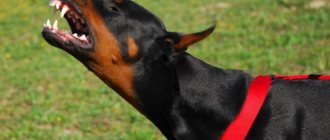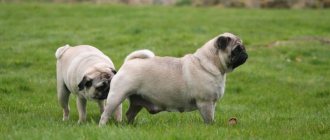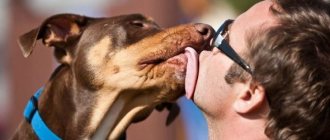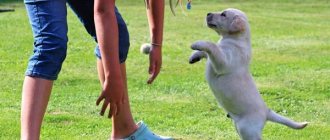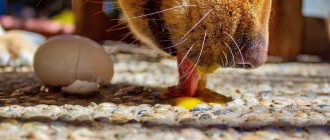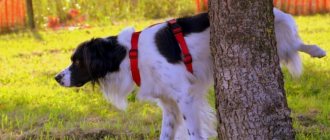A dog animatedly spinning around its axis in an attempt to catch its own tail looks funny. Sometimes even owners who know their pet well mistake this behavior for a game. However, experts say: the animal may not be having fun at the moment. Often attempts to reach the back of the body with teeth indicate various health problems.
Why does a dog chase its tail?
Funny habit
A puppy can chase its tail only after becoming familiar with it. He does not perceive it as part of himself, but sees it as a toy. As soon as the dog has had enough of playing, discovering more interesting activities for himself, he gives up the chase.
Dogs create their own entertainment
One way to have fun
A dog may chase its tail out of boredom. This way she brightens up the hours spent alone. Perhaps the dog will notice that he can play with his tail as an adult, then he will have fun spinning around himself for a short time.
Note! Usually animals quickly forget about this funny habit, switching to active games while walking.
Symptoms that should prompt you to visit the veterinarian
The owner is not always able to solve the problem on his own. If dangerous symptoms appear, it is better to seek help from a veterinarian:
- impaired coordination of movements;
- unconscious jaw clicking;
- compulsive licking of body parts;
- chewing fur, even if there are no fleas or other skin parasites;
- eating one's own and other people's feces;
- aggressive behavior for no apparent reason;
- malevolent attitude towards females.
“Hunting” for the tail is a signal to the owner that not everything is all right with his pet. You should not punish your dog for this behavior. Carefully examine the animal for possible causes and contact a specialist for help if necessary.
Why does a dog chase its tail?
Why does a dog chase its tail?
When a dog chases its tail, the reasons can be different: from a harmless way to get rid of boredom to the presence of serious pathologies.
Most often, the pet's behavior is explained as follows:
- The dog has nowhere to put his energy. This is especially true for representatives of active breeds that require daily walking and physical activity. If they spend most of their time in a limited area, they begin to chase their tail;
- the animal gets too tired and exhausted during training. Nervous excitement reduces tail chasing;
- the pet attracts the owner’s attention;
- the dog experiences physical discomfort;
- The dog has neurological problems and a mental disorder.
Instinct
Many dogs first walk in circles and only then go to bed. And this is a completely natural behavior that probably comes from their ancestors. After all, once upon a time, undomesticated dogs were forced to spend the night on the street and sleep without relying on outside warmth. Therefore, the dog prepared its sleeping place by trampling leaves or snow around it before going to bed.
It is also possible that the dog also does this because he wants to be more aware of objects and dangers around him, because this allows him to look around and assess whether there are enemies nearby (such as snakes, for example).
Possible health problems
Sometimes tail chasing can be a symptom of a problem with your dog's body. It is worth contacting a veterinarian if your pet spends too much time doing this activity. Perhaps he has psychological disorders.
Catching Tail Syndrome
A dog licks its anus under its tail: why does this happen?
Some dogs are susceptible to a genetic disease, the main symptom of which is tail catching. Running in a circle, the animal whines, barks, growls, and even squeals. It spins for about 10-15 minutes. contract. After a certain period of time, the dog returns to his occupation again. Obsessive behavior can manifest itself in other ways:
- the animal walks from corner to corner;
- chews paws, sides, as if trying to catch fleas;
- the dog looks around and clicks its teeth as if catching flies;
- The dog constantly licks himself.
The pet becomes too excitable and aggressive. He needs to be given as much attention as possible and protected from stress.
Note! It will not be possible to completely get rid of the syndrome, but there is a chance to reduce its manifestation. The veterinarian will tell you how best to do this.
Hormonal imbalances
During pregnancy and nursing puppies, the female's behavior changes. She may lick herself constantly, become short-tempered, or become very affectionate. Some people feel the urge to grab their own tail. Once the hormone levels return to normal, the animal will be the same as before.
Helminth infection
Once every six months, dogs must be given anti-worm medications. If the animal has raw meat in its food, it is recommended to undergo prophylaxis more often. When they stay in the body for a long time, helminths poison it, worsening the pet’s health. In addition, they cause irritation and itching in the anal area. The dog, spinning around himself, tries to get to the damaged areas and get rid of the sensations that torment him.
Mental disorders
If a pet has experienced a nervous shock, this may affect its psyche. Even a loud bang, a shot, or another unfamiliar sound can scare a pet.
Note! Starting to run after its tail, the dog tries to forget about the unpleasant impressions. It's like he's distracting himself.
Discomfort
Any unpleasant sensations in the anus lead to the animal running after its tail:
- The dog suffers from an allergy accompanied by itching. He tries to reach the disturbing places; most often, getting to the tail turns out to be the easiest;
- The animal's tail was docked unsuccessfully. The operation was performed poorly, the bone partially remained, which causes pain;
- after a walk, for example, a burdock got stuck in the tail. The animal tries to get rid of it;
- If the room is too stuffy and the street is hot and dry, dogs often experience skin irritation. Then the animal becomes restless and begins to run in circles;
- inflammation of the anal glands, which often develops in pets that exercise little, leads to changes in behavior. The dog licks the area under the tail and tries to bite it.
What should the owner do?
Of course, a dog owner can help his pet, and this should definitely be done. The owner’s actions directly depend on what specific reason provokes this behavior of the dog:
- psychological aspects - try to devote enough time to your pet. Walk with him regularly and play. Eliminate external factors that may disturb the dog. This could be, for example, third parties, other animals, children who do not always understand what they are doing with the dog;
- ticks, fleas, etc. – carefully examine the dog’s anal area. If you see a tick or fleas running around, it means you need to fight them. The ticks are removed very carefully so as not to leave the head in the wound. Fleas can be eliminated using appropriate shampoos or collars;
- worms - you will need to do an analysis that will help determine the type of parasite and prescribe adequate treatment. To avoid re-infection, you will need to give your animal deworming medications from time to time as a preventative measure;
- inflammation of the paraanal glands - you can clean them yourself, the veterinarian will tell you how to do this. And for the first time you should always contact a specialist, and the sooner the better;
- allergies – protect your pet from the allergen. We will have to find out what exactly provokes an allergic response from the animal’s body;
- skin diseases - contact your veterinarian, who will determine the type of disease and prescribe appropriate treatment.
Does this behavior depend on the breed?
Why does a cat bite its owner’s legs: when you stroke it and for no reason
Any dog can play with its tail for a short time. If he doesn't constantly return to this activity, there's no need to worry.
Manifestation of the syndrome in a pet
Some breeds are more susceptible to a disorder called caught-tail syndrome:
- German Shepherd;
- bull terrier;
- collie;
- Jack Russell Terrier.
Note! The disease becomes noticeable at an early age. And such pets are not recommended for breeding, since there is a high risk that the syndrome will be passed on to offspring.
Infections
Ear infections are a common cause of circling in dogs, and deep or persistent infections are usually the most worrisome. Severe cases are very dangerous and can lead to deafness, facial paralysis, vestibular disorders such as head tilting, circling and lack of coordination. Symptoms of a typical ear infection include head shaking, foul odor, and swelling. Therefore, it is important to regularly check your dog's ears for any of these signs and seek treatment from your veterinarian.
Spring has come, and with it allergies: simple ways to protect yourself from it. A nutritionist said that pancakes with fish should be preferred. What is “unprecedented happiness” for Maria Aronova and has she found it in life?
Additionally, there are many other infections that can cause a dog to walk in circles. Any of these that affect the brain or nervous system can cause loss of coordination. For example, pets with canine distemper may experience circling, head tilting, muscle spasms, spasms with chewing movements of the jaw, and drooling. Therefore, it is important to get your dog vaccinated and contact your veterinarian immediately at the first sign of illness.
How to stop a dog from chasing its tail
To make your pet forget about playing with its tail, you need to use the following recommendations:
- try to find the reason for this behavior, if you can get rid of the provoking factor. So, perhaps your pet has mats or is bothered by fleas;
- spend more time with the dog, introduce him to sports. Many dogs happily play Frisbee, fetch balls, and go through obstacle courses;
- It is advised to use the technique of switching the pet’s attention to another activity, giving him familiar commands, waiting for them to be completed;
- You can’t scold a dog by simply forbidding him to run in a circle. It will not be possible to wean an animal this way. It may begin to do this away from the owner or find another bad habit.
It's not so easy to wean yourself off pranks
There are a number of reasons why a dog often chases its tail; they cannot always be avoided in order to completely cure the pet. Consulting a doctor won't hurt in any case. You cannot ignore a dog that constantly catches its tail and bites it. This behavior impairs the functioning of the vestibular apparatus and causes dizziness. Ultimately, the animal's quality of life suffers. Then the dog’s circular movements cannot be considered a funny habit; there are physiological or psychological problems behind it.
Help from specialists
The unwanted behavior itself can be removed, but this will not affect the psychological decision. Moreover, it is difficult to perform a stereotypical action without anxiety. The important thing here is not to scold the dog, but to understand what factor provokes negative behavior and remove it. It is important for a pet to understand that it is the owner who must control its behavior. Simply put, learn new movements.
Initially, the dog is taught well-known commands. First, this is done in the absence of stimuli, and then, when she has completely calmed down and adapted, they are gradually introduced. At first this is done in a weakened form, while the degree of irritability increases each time. For example, if your pet is annoyed by a ringing call, then you should record its sound on your phone and turn it on quietly.
It is important not to rush things here, because when unwanted behavior occurs, it is important to pause the training and take a few steps back. To improve the result, it is important not only to constantly praise the dog, but also to treat it with treats. The dog handler himself draws up a schedule for the exercises and determines when to move on to the next stage. The training process can last from several weeks to a month.
In parallel with training, veterinarians recommend that the dog take a course of medications. Surely many had no idea that a pet’s innocent play with its tail can signal serious problems that owners should definitely pay attention to.
Diagnostics
To identify the cause of the disease, diagnostics will be required, which will include a number of measures:
- visual inspection of the places that the dog combs, as well as for the presence of parasites in the fur;
- blood test to detect the presence of allergies;
- scraping from damaged areas to detect microorganisms.
Important! After the diagnosis, the veterinarian, if necessary, prescribes treatment and suggests why and what the owners should do to correct the situation.
You should not diagnose the problem yourself, because such a solution can harm the health of the animal.
Vestibular disease
Vestibular disease is another common cause of dogs pacing, especially if they are older. Vestibular problems can also cause head tilt, loss of coordination, nausea and vomiting. Symptoms can occur spontaneously, and veterinarians are often unable to pinpoint their source.
Fortunately, vestibular disease often resolves with supportive care. Make sure your dog eats and drinks well, and make sure he doesn't lose his balance in dangerous areas. But it's still important to visit your veterinarian because anxiety tends to develop into more serious consequences, such as a stroke or brain tumor.
Plans for the future and reasons for aggression on the part of the dog
If the pet begins to growl at the owner for no particular reason, you should immediately understand that the initial level has been passed. The animal is at the second stage, near which the prerequisites have already been lost. But it is not advisable to despair; any behavior can be corrected if measures are taken without delay. When a person plans to get a puppy, it is necessary to study its temperament and identify the preconditions for aggression if they exist. Before an animal starts to parry or bite, you will notice a number of signs leading up to it. This includes manners, gestures, stance, and another set of actions. Hostility can be dominant. In this case, the animal will jump into your arms, wanting to be on top. This color is typical for pets who want to be the head of the pack, leader, authority. This is inherent in nature, because in a pack of dogs, no more dominant individual can crush the younger one in rank. That’s all you need to know, that when a dog tries to get into the owner’s room, it considers itself to be in charge, and does not take the owner of the console into account at all. Sexual aggression is just one type with which the owners of male dogs are familiar firsthand to this day. The dog exhibits aggressive behavior in the area towards relatives of the same sex. Even male puppies will compete for a toy or territory with their brothers. In order to avoid a person, such aggression is dangerous, because (the pet can transfer it in your direction at any second. The situation is complicated when the dog growls at the owner if he reproaches him. The solution lies in castration, and in turn, the correct education of the animal. Aggression may be territorial, sympathy is determined by the developed protective qualities of the four-legged friend. Such instincts must be manifested intelligently. Otherwise, the student will cross all boundaries, trying to protect the house from the owner. This cannot be allowed. So-called food aggression may appear in dogs. In this case, feeding growls or even bites the owner if someone reaches out to her bowl. The same applies to situations when treating a pet with a treat, he grabs sausages. An adult will freeze, growl or grin while eating if a person passes nearby. To problems of a behavioral nature it is possible to attribute aggression between two individuals living near the same roof
They fight for territory, leprosy, food and the attention of the owner. The danger is what's the matter? at any moment a dog can turn its anger into a person
The prerequisites are behavior in which the ignoramus pushes the child away in order to quickly approach his dad/mom. Such signs must be stopped at an early stage. Self-defense or defensive attack. There is a certain rule among experienced dog breeders. If (soon) you scold your pet, you need to pursue his circle of interests. Owners often make many serious mistakes. The process is that the training, training and socialization of the dog is done intentionally for the dog's safety and comfort. The simple execution of commands under no circumstances affects the convenience of the owner, however, such procedures on each other’s heads are connected with you. If the animal obeys the owner, it will not run away and will not get into trouble. The best thing is that the dog will not fight with its relatives. The prerequisites for aggression may be a desire to hide and fear. Faced with cowardice and timidity, one can assume that the animal has lost trust in its owner. This alteration is very bad. If your pet cannot trust you, he will be under constant stress. A four-legged (helper) will always strive for safety. This has always been the basic instinct of animals. Unless you ignore this, the dog’s psyche suffers greatly. Who (everything can be corrected, it just takes time to earn the dog’s trust. Protective militarism. Such a reaction can be quite logical, unless the animal is in real danger. This can also be supported by the owner. You may even have little-: illiterate knowledge that you are a threat. The pet may be very afraid of your voice, gestures and too active body movements. Walk far away no need, for example, you returned from an event drunk, the mongrel smells a different smell and sees an unusual attitude towards it. You start talking to you differently, the animal may think, so to speak, you have been replaced. Such statements are very vague, on average the reaction of each dog breed can ( remain different.
